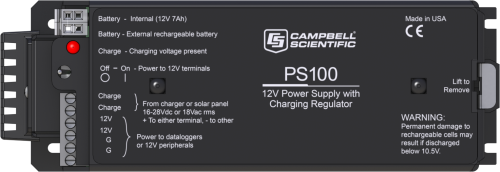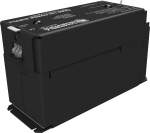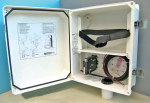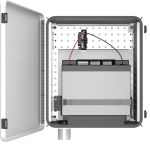This product is not available for new orders.

| Services Available | |
|---|---|
| Repair | No |
| Calibration | No |
| Free Support | No |
Overview
The PS100 provides a 12-Vdc, 7-Ah rechargeable power supply for the CR500, CR510, CR800, CR850, CR10, CR10X, and CR1000 dataloggers and peripherals. The rechargeable battery can be trickle-charged from ac power (requires optional wall charger) or from an external solar panel. The user can add an external rechargeable battery.
Read MoreImages








3D/CAD Files:
Detailed Description
The PS100 can also be used as a separate auxiliary 12-V power supply to power remotely located sensors or peripherals, such as a multiplexer located at a distance from the datalogger enclosure. However, to avoid errors in analog measurements and ground loops, the power supplies must share a common ground.
Compatibility
Please note: The following shows notable compatibility information. It is not a comprehensive list of all compatible products.
Dataloggers
| Product | Compatible | Note |
|---|---|---|
| 21X (retired) | ||
| CR10 (retired) | ||
| CR1000 (retired) | ||
| CR10X (retired) | ||
| CR200X (retired) | ||
| CR206X (retired) | ||
| CR211X (retired) | ||
| CR216X (retired) | ||
| CR23X (retired) | Typically, a CR23X, CR3000, or CR5000 datalogger uses its integrated rechargeable base instead of the PS100. However, the PS100 can be used if the data logger has a low-profile base or if the battery base has been disconnected. | |
| CR295X (retired) | ||
| CR3000 (retired) | Typically, a CR23X, CR3000, or CR5000 datalogger uses its integrated rechargeable base instead of the PS100. However, the PS100 can be used if the data logger has a low-profile base or if the battery base has been disconnected. | |
| CR500 (retired) | ||
| CR5000 (retired) | Typically, a CR23X, CR3000, or CR5000 datalogger uses its integrated rechargeable base instead of the PS100. However, the PS100 can be used if the data logger has a low-profile base or if the battery base has been disconnected. | |
| CR510 (retired) | ||
| CR6 | ||
| CR800 (retired) | ||
| CR850 (retired) | ||
| CR9000 (retired) | ||
| CR9000X (retired) |
Additional Compatibility Information
Enclosure Considerations
A desiccated, non-condensing environment is required. The PS100 includes built-in keyhole flanges for mounting to the backplate of a Campbell Scientific enclosure.
Adapters
The PS100 is compatible with the A100 null-modem adapter and the A105 adapter for additional 12 V output terminals. The A100 Null Modem Adapter connects and powers two Campbell Scientific peripherals via two CS I/O 9-pin connectors configured as a null modem. This is useful in linking different communications technologies, such as telephone to radio, at sites that do not have a data logger. The A105 adapter may be used to provide additional 12 V and ground terminals where the power supply is used to power several devices.
Charging Source
The PS100 charges with a 24 V input. However, when the battery is discharged or the system is pulling high current (about 700 mA), the regulator overheats. This, in turn, limits the charging time because the regulator is heating up until it gets so hot that it shuts down. At this point, the regulator stops charging the battery until the regulator cools down and starts charging again. This cycle repeats until the battery is charged enough so that the regulator no longer overheats. For a system with a constant current drain of 0.7 A or higher, the PS100 is not able to keep the battery charged unless the input voltage is between 16 and 20 V. If the input voltage is between 16 and 20 V, the regulator outputs continuously up to a 1.2 A load.
Specifications
| input Voltage (CHG Terminals) | 15 to 28 Vdc or 18 Vac RMS |
| Charging Output Voltage | Temperature compensated float charge (for 12 V battery) |
| Output Limit (12V and G Terminals) | 3.0 A (temperature dependent) |
| Charging Current Limit | 1.2 A (typical) |
| Power Out (+12 Terminals) Voltage | Unregulated 12 V (from battery) |
| Nominal Rating | 7 Ah |
| Dimensions | 10.5 x 19.3 x 7.1 cm (4.1 x 7.6 x 2.8 in.) including mounts and connectors |
| Weight | 3.1 kg (6.9 lb) |
| Battery Weight | 2.7 kg (5.9 lb) |
Quiescent Current |
|
| Charge Source Present | 3 to 5 mA |
| No Charge Source Present | 0 mA |
Documents
Technical Papers
Videos & Tutorials
Frequently Asked Questions
Number of FAQs related to PS100: 7
Expand AllCollapse All
-
The voltage from a solar panel will fluctuate throughout the day.
If AC power is being used, the voltage is usually stable.
The voltages coming into the regulator inputs are controlled so that the battery won’t be overcharged (and thus ruined by boiling out the electrolyte). If the battery connected to the regulator is good, the highest voltage you will likely see is just above 14 Vdc in the extreme cold, but normally it should be around 13.2 Vdc.
If you have a nearly dead battery (to be checked with a voltmeter) or a battery with shorted cells, you will see a very low battery voltage. The lowest voltage you will see on the data logger data is usually about 10.0 V because the data logger will shut down near that level and then wait for the voltage to increase to an 11- or 12-volt level.
The ripple voltage is a few millivolts flowing into the battery, but the battery should filter out most of that noise, providing a pretty stable voltage.
-
Yes. The G and 12V terminals on the charge regulator are used to connect the black and red wires that connect with the green connector, which provides power to the data logger.
-
Look for a stamp on top of the battery. The stamp may be in a date format of YYMMDDXX where:
- YY is the year.
- MM is the month.
- DD is the day.
- XX is the manufacturing plant.
This indicates the age of the battery.
-
Most would terminate the ac line in an ordinary duplex receptacle box inside the enclosure. It is not recommended that you use the same conduit access hole that your signal leads are fed through, as that may induce unwanted noise in your signals. Then, simply connect the 9591 wall transformer from the receptacle to the PS100 charge terminals. The PS100 (or CH100) expects either 18 Vac or 18 Vdc that's limited to no more than 1.2 amps.
-
Yes. On the order, specify pn 6182.
-
The PS100 (and CH100) are limited to 1.2 A of input. Because the SP20 20 W solar panel generates 1.17 A, that single panel represents a practical limitation to the input. For panels that generate current greater than 1.2 A, consider the PS200, Smart Power Supply and Charge Controller, or CH200, Smart 12 V Charging Regulator, for up to 3 A of input, or pn 18529, 10 A, 12 V, Morningstar Regulator, which is capable of accepting 10 A of input.
Generally, it is not recommended to connect more than one panel at a time. Differential shading can cause issues, such as the shaded panel acting as a current sink.
-
The PS100, PS150, and PS200 models take in AC or DC power from a wall transformer or a solar panel. The internal regulator controls the charge to the battery to make sure the battery doesn’t become overcharged (based on temperature).
If the switch is on, the voltage from the battery will flow back out from the regulated battery to the loads; however, the voltage on that battery may be 11.9 V, 13.2 V, or some other value that the battery happens to be at. It is important to understand that the voltage will not always be exactly 12.0 Vdc. Rather, the voltage will float up or down as the battery is recharged or depleted.
Casos de estudio
The Solar Decathlon takes place every other year on the National Mall in Washington, D.C.......read more
The Mount Washington Observatory in New Hampshire is one of the oldest weather observatories in......read more




